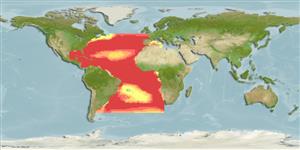Classification / Names
Common names from other countries
Main reference
Size / Weight / Age
Max length : 500 cm TL male/unsexed; (Ref. 11441); 500.0 cm TL (female); common length : 290 cm TL male/unsexed; (Ref. 6659); max. published weight: 636.0 kg (Ref. 40637); max. published weight: 636.0 kg
Length at first maturity
Lm ?, range 50 - ? cm
Environment
Marine; pelagic-oceanic; oceanodromous (Ref. 51243); depth range 0 - 200 m (Ref. 43)
Climate / Range
Subtropical; 22°C - 31°C (Ref. 43), preferred 27°C (Ref. 107945); 50°N - 45°S, 98°W - 17°E (Ref. 43)
Distribution
Atlantic Ocean: in tropical and temperate waters. We follow Nakamura 1985 (Ref. 43) in recognizing Makaira mazara and Makaira nigricans as two distinct species chiefly because of differences in the pattern of the lateral line system. Many scientists, however, do not recognize this character as specifically diagnostic and consider the latter species as a single pantropical species occurring in the Atlantic, Pacific and Indian oceans. Highly migratory species, Annex I of the 1982 Convention on the Law of the Sea (Ref. 26139).
Countries | FAO areas | Ecosystems | Occurrences | Introductions
Short description
Dorsal
spines
(total): 0;
Dorsal
soft rays
(total): 45-50;
Anal
spines: 0;
Anal
soft rays: 19 - 23. Body blue-black above and silvery white below, with about 15 rows of pale cobalt-colored stripes; 1st dorsal fin plain blackish or dark blue, other fins brown black with a tinge of dark blue in some specimens; anal fin bases with a tinge of silvery white. Lateral line a network of interconnecting canals (Ref. 26938).
IUCN Red List Status (Ref. 115185)
Threat to humans
Harmless
Human uses
Fisheries: commercial; gamefish: yes
More information
ReferencesAquacultureAquaculture profileStrainsGeneticsAllele frequenciesHeritabilityDiseasesProcessingMass conversion
Tools
Special reports
Download XML
Internet sources
Estimates of some properties based on models
Phylogenetic diversity index
PD50 = 0.7505 many relatives (e.g. carps) 0.5 - 2.0 few relatives (e.g. lungfishes)
Trophic Level
4.5 ±0.3 se; Based on diet studies.
Resilience
Medium, minimum population doubling time 1.4 - 4.4 years (K=0.1-0.3)
Vulnerability
Moderate to high vulnerability (52 of 100)
Price category
